ignition FIAT SCUDO 2012 Owner handbook (in English)
[x] Cancel search | Manufacturer: FIAT, Model Year: 2012, Model line: SCUDO, Model: FIAT SCUDO 2012Pages: 219, PDF Size: 4.13 MB
Page 85 of 219
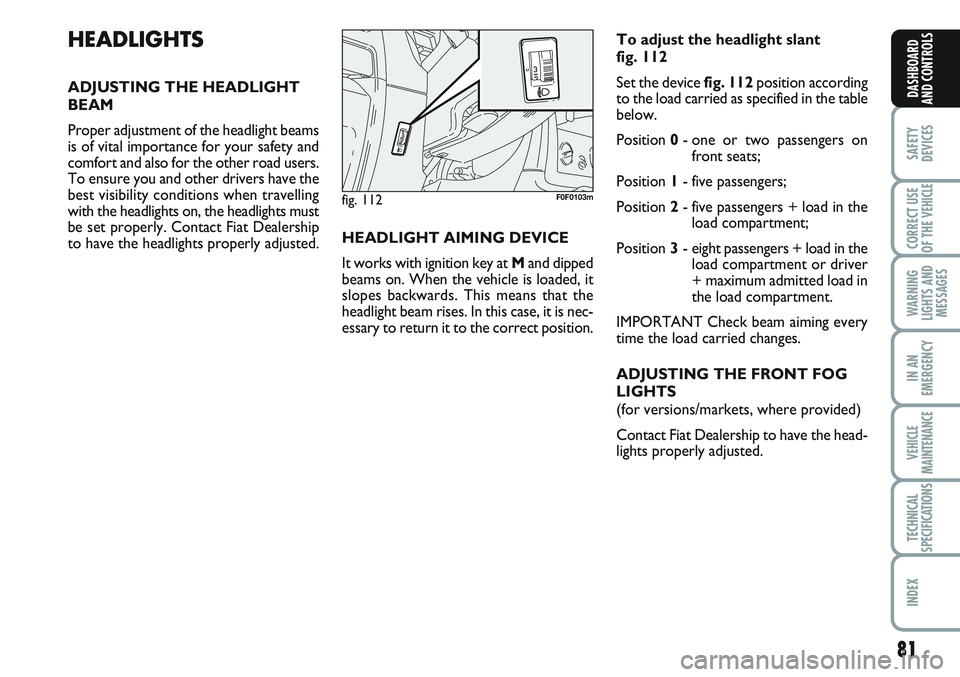
81
SAFETY
DEVICES
CORRECT USE
OF THE
VEHICLE
WARNING
LIGHTS AND
MESSAGES
IN AN
EMERGENCY
VEHICLE
MAINTENANCE
TECHNICAL
SPECIFICATIONS
INDEX
DASHBOARD
AND CONTROLS
HEADLIGHTS
ADJUSTING THE HEADLIGHT
BEAM
Proper adjustment of the headlight beams
is of vital importance for your safety and
comfort and also for the other road users.
To ensure you and other drivers have the
best visibility conditions when travelling
with the headlights on, the headlights must
be set properly. Contact Fiat Dealership
to have the headlights properly adjusted.HEADLIGHT AIMING DEVICE
It works with ignition key at Mand dipped
beams on. When the vehicle is loaded, it
slopes backwards. This means that the
headlight beam rises. In this case, it is nec-
essary to return it to the correct position.To adjust the headlight slant
fig. 112
Set the device fig. 112position according
to the load carried as specified in the table
below.
Position 0- one or two passengers on
front seats;
Position 1- five passengers;
Position 2- five passengers + load in the
load compartment;
Position 3- eight passengers + load in the
load compartment or driver
+ maximum admitted load in
the load compartment.
IMPORTANT Check beam aiming every
time the load carried changes.
ADJUSTING THE FRONT FOG
LIGHTS
(for versions/markets, where provided)
Contact Fiat Dealership to have the head-
lights properly adjusted.
fig. 112F0F0103m
Page 91 of 219
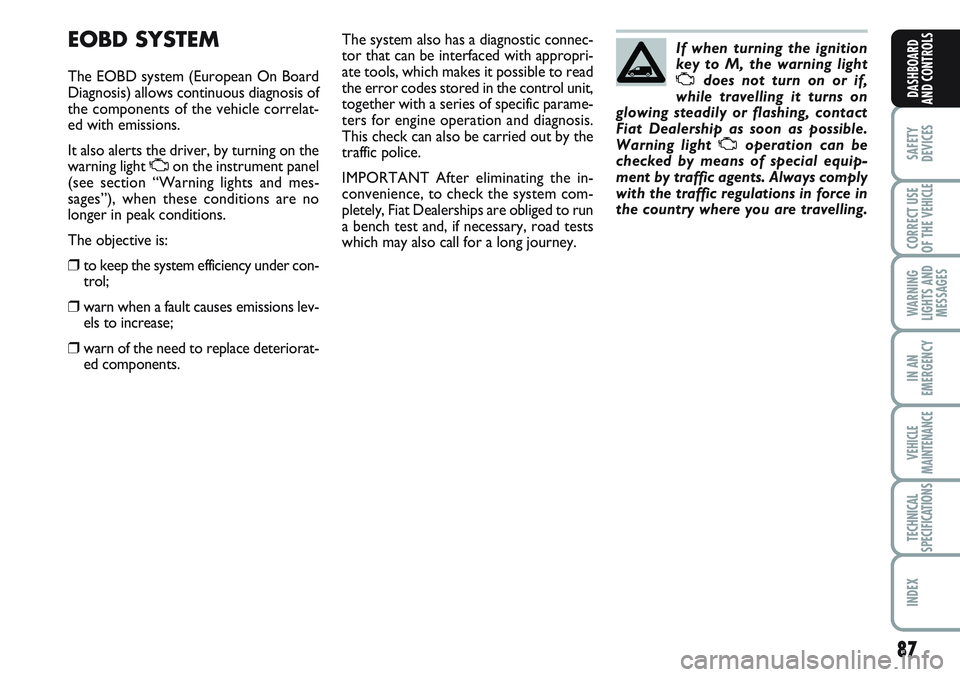
87
SAFETY
DEVICES
CORRECT USE
OF THE
VEHICLE
WARNING
LIGHTS AND
MESSAGES
IN AN
EMERGENCY
VEHICLE
MAINTENANCE
TECHNICAL
SPECIFICATIONS
INDEX
DASHBOARD
AND CONTROLS
EOBD SYSTEM
The EOBD system (European On Board
Diagnosis) allows continuous diagnosis of
the components of the vehicle correlat-
ed with emissions.
It also alerts the driver, by turning on the
warning light
Uon the instrument panel
(see section “Warning lights and mes-
sages”), when these conditions are no
longer in peak conditions.
The objective is:
❒to keep the system efficiency under con-
trol;
❒ warn when a fault causes emissions lev-
els to increase;
❒warn of the need to replace deteriorat-
ed components.The system also has a diagnostic connec-
tor that can be interfaced with appropri-
ate tools, which makes it possible to read
the error codes stored in the control unit,
together with a series of specific parame-
ters for engine operation and diagnosis.
This check can also be carried out by the
traffic police.
IMPORTANT After eliminating the in-
convenience, to check the system com-
pletely, Fiat Dealerships are obliged to run
a bench test and, if necessary, road tests
which may also call for a long journey.If when turning the ignition
key to M, the warning light
Udoes not turn on or if,
while travelling it turns on
glowing steadily or flashing, contact
Fiat Dealership as soon as possible.
Warning light Uoperation can be
checked by means of special equip-
ment by traffic agents. Always comply
with the traffic regulations in force in
the country where you are travelling.
Page 96 of 219
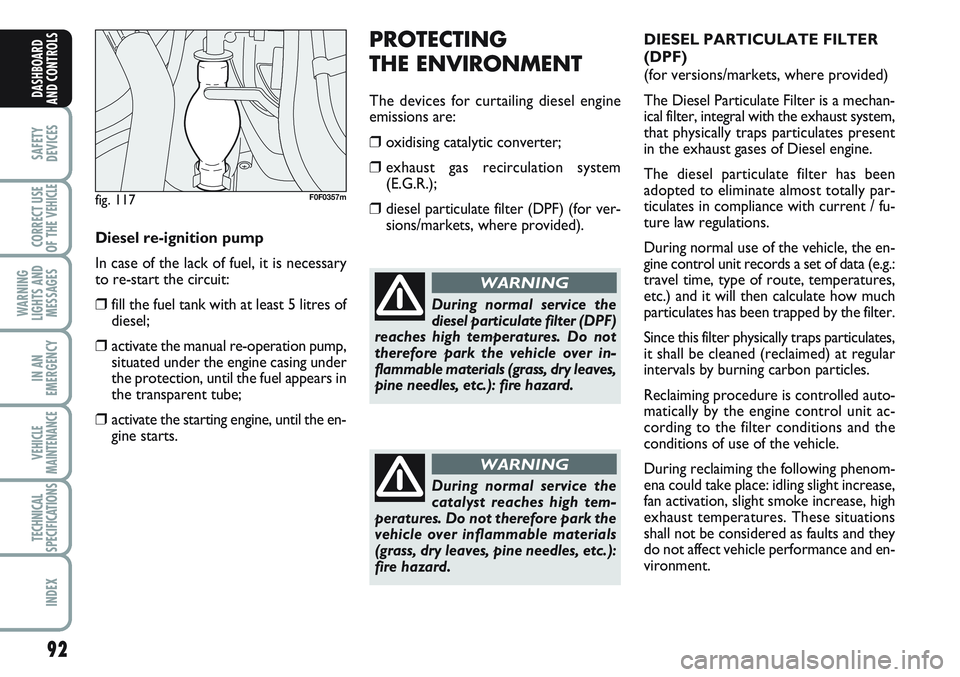
92
SAFETY
DEVICES
CORRECT USE
OF THE
VEHICLE
WARNING
LIGHTS AND
MESSAGES
IN AN
EMERGENCY
VEHICLE
MAINTENANCE
TECHNICAL
SPECIFICATIONS
INDEX
DASHBOARD
AND CONTROLS
DIESEL PARTICULATE FILTER
(DPF)
(for versions/markets, where provided)
The Diesel Particulate Filter is a mechan-
ical filter, integral with the exhaust system,
that physically traps particulates present
in the exhaust gases of Diesel engine.
The diesel particulate filter has been
adopted to eliminate almost totally par-
ticulates in compliance with current / fu-
ture law regulations.
During normal use of the vehicle, the en-
gine control unit records a set of data (e.g.:
travel time, type of route, temperatures,
etc.) and it will then calculate how much
particulates has been trapped by the filter.
Since this filter physically traps particulates,
it shall be cleaned (reclaimed) at regular
intervals by burning carbon particles.
Reclaiming procedure is controlled auto-
matically by the engine control unit ac-
cording to the filter conditions and the
conditions of use of the vehicle.
During reclaiming the following phenom-
ena could take place: idling slight increase,
fan activation, slight smoke increase, high
exhaust temperatures. These situations
shall not be considered as faults and they
do not affect vehicle performance and en-
vironment.
During normal service the
diesel particulate filter (DPF)
reaches high temperatures. Do not
therefore park the vehicle over in-
flammable materials (grass, dry leaves,
pine needles, etc.): fire hazard.
WARNING
During normal service the
catalyst reaches high tem-
peratures. Do not therefore park the
vehicle over inflammable materials
(grass, dry leaves, pine needles, etc.):
fire hazard.
WARNING
PROTECTING
THE ENVIRONMENT
The devices for curtailing diesel engine
emissions are:
❒oxidising catalytic converter;
❒ exhaust gas recirculation system
(E.G.R.);
❒diesel particulate filter (DPF) (for ver-
sions/markets, where provided).
Diesel re-ignition pump
In case of the lack of fuel, it is necessary
to re-start the circuit:
❒ fill the fuel tank with at least 5 litres of
diesel;
❒ activate the manual re-operation pump,
situated under the engine casing under
the protection, until the fuel appears in
the transparent tube;
❒ activate the starting engine, until the en-
gine starts.
fig. 117F0F0357m
Page 100 of 219
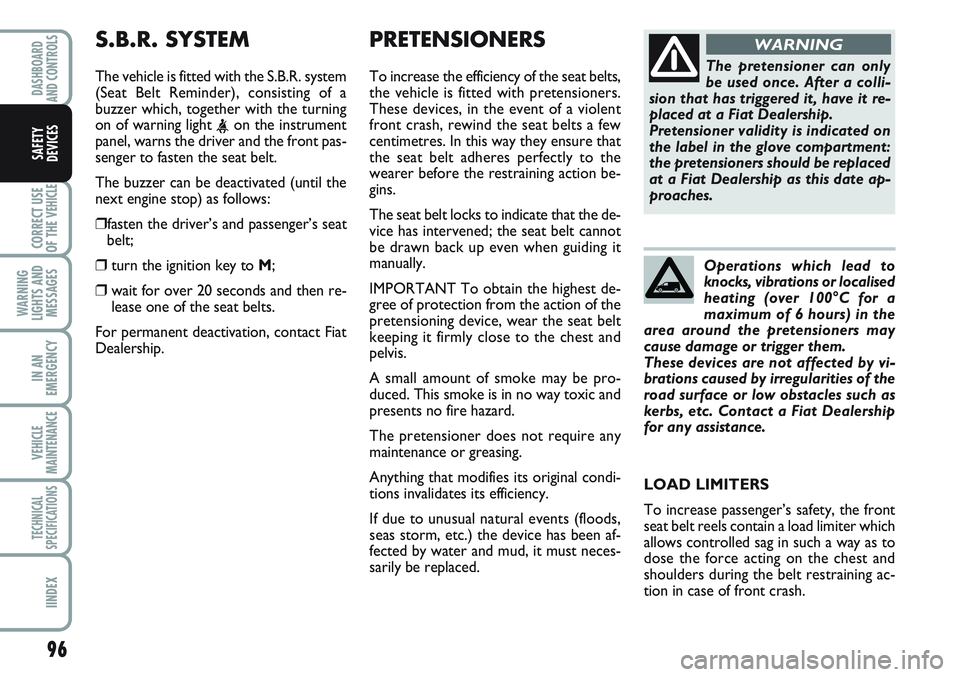
96
CORRECT USE
OF THE
VEHICLE
WARNING
LIGHTS AND
MESSAGES
IN AN
EMERGENCY
VEHICLE
MAINTENANCE
TECHNICAL
SPECIFICATIONS
IINDEX
DASHBOARD
AND CONTROLS
SAFETY
DEVICES
PRETENSIONERS
To increase the efficiency of the seat belts,
the vehicle is fitted with pretensioners.
These devices, in the event of a violent
front crash, rewind the seat belts a few
centimetres. In this way they ensure that
the seat belt adheres perfectly to the
wearer before the restraining action be-
gins.
The seat belt locks to indicate that the de-
vice has intervened; the seat belt cannot
be drawn back up even when guiding it
manually.
IMPORTANT To obtain the highest de-
gree of protection from the action of the
pretensioning device, wear the seat belt
keeping it firmly close to the chest and
pelvis.
A small amount of smoke may be pro-
duced. This smoke is in no way toxic and
presents no fire hazard.
The pretensioner does not require any
maintenance or greasing.
Anything that modifies its original condi-
tions invalidates its efficiency.
If due to unusual natural events (floods,
seas storm, etc.) the device has been af-
fected by water and mud, it must neces-
sarily be replaced.LOAD LIMITERS
To increase passenger’s safety, the front
seat belt reels contain a load limiter which
allows controlled sag in such a way as to
dose the force acting on the chest and
shoulders during the belt restraining ac-
tion in case of front crash.The pretensioner can only
be used once. After a colli-
sion that has triggered it, have it re-
placed at a Fiat Dealership.
Pretensioner validity is indicated on
the label in the glove compartment:
the pretensioners should be replaced
at a Fiat Dealership as this date ap-
proaches.
WARNING
Operations which lead to
knocks, vibrations or localised
heating (over 100°C for a
maximum of 6 hours) in the
area around the pretensioners may
cause damage or trigger them.
These devices are not affected by vi-
brations caused by irregularities of the
road surface or low obstacles such as
kerbs, etc. Contact a Fiat Dealership
for any assistance.
S.B.R. SYSTEM
The vehicle is fitted with the S.B.R. system
(Seat Belt Reminder), consisting of a
buzzer which, together with the turning
on of warning light
senger to fasten the seat belt.
The buzzer can be deactivated (until the
next engine stop) as follows:
❒fasten the driver’s and passenger’s seat
belt;
❒turn the ignition key to M;
❒wait for over 20 seconds and then re-
lease one of the seat belts.
For permanent deactivation, contact Fiat
Dealership.
Page 112 of 219
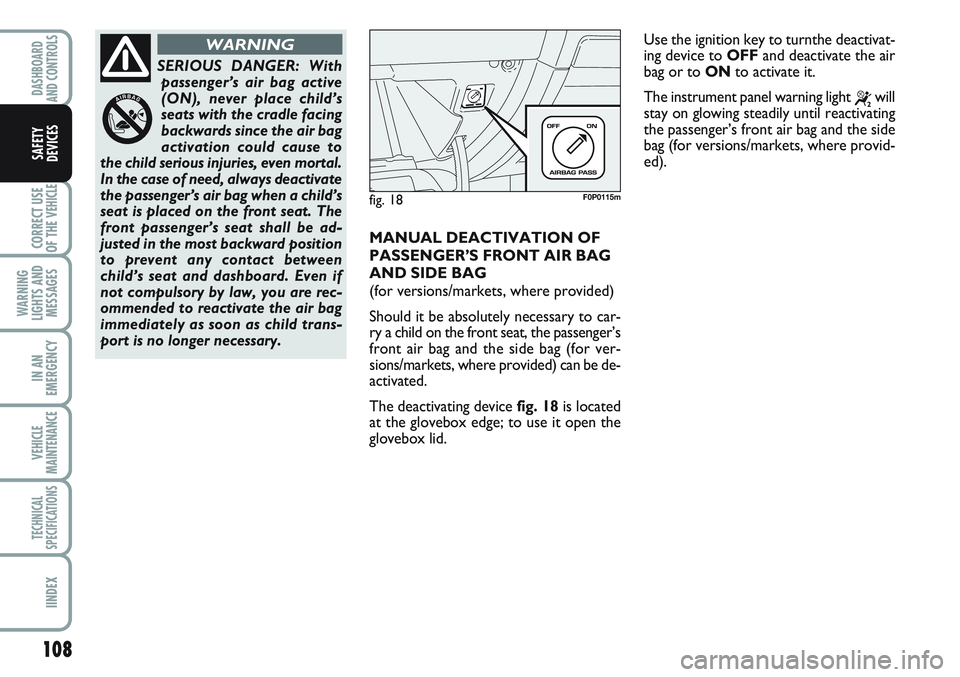
108
CORRECT USE
OF THE
VEHICLE
WARNING
LIGHTS AND
MESSAGES
IN AN
EMERGENCY
VEHICLE
MAINTENANCE
TECHNICAL
SPECIFICATIONS
IINDEX
DASHBOARD
AND CONTROLS
SAFETY
DEVICES
MANUAL DEACTIVATION OF
PASSENGER’S FRONT AIR BAG
AND SIDE BAG
(for versions/markets, where provided)
Should it be absolutely necessary to car-
ry a child on the front seat, the passenger’s
front air bag and the side bag (for ver-
sions/markets, where provided) can be de-
activated.
The deactivating device fig. 18is located
at the glovebox edge; to use it open the
glovebox lid.
SERIOUS DANGER: With
passenger’s air bag active
(ON), never place child’s
seats with the cradle facing
backwards since the air bag
activation could cause to
the child serious injuries, even mortal.
In the case of need, always deactivate
the passenger’s air bag when a child’s
seat is placed on the front seat. The
front passenger’s seat shall be ad-
justed in the most backward position
to prevent any contact between
child’s seat and dashboard. Even if
not compulsory by law, you are rec-
ommended to reactivate the air bag
immediately as soon as child trans-
port is no longer necessary.
WARNING
fig. 18F0P0115m
Use the ignition key to turnthe deactivat-
ing device to OFFand deactivate the air
bag or to ONto activate it.
The instrument panel warning light
“will
stay on glowing steadily until reactivating
the passenger’s front air bag and the side
bag (for versions/markets, where provid-
ed).
Page 116 of 219
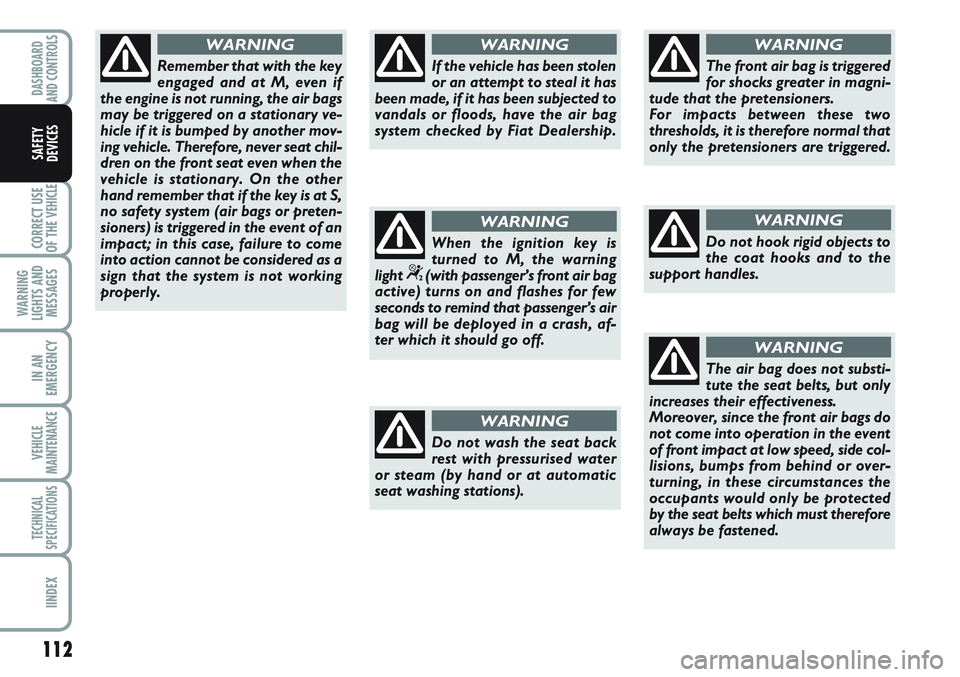
112
CORRECT USE
OF THE
VEHICLE
WARNING
LIGHTS AND
MESSAGES
IN AN
EMERGENCY
VEHICLE
MAINTENANCE
TECHNICAL
SPECIFICATIONS
IINDEX
DASHBOARD
AND CONTROLS
SAFETY
DEVICES
Remember that with the key
engaged and at M, even if
the engine is not running, the air bags
may be triggered on a stationary ve-
hicle if it is bumped by another mov-
ing vehicle. Therefore, never seat chil-
dren on the front seat even when the
vehicle is stationary. On the other
hand remember that if the key is at S,
no safety system (air bags or preten-
sioners) is triggered in the event of an
impact; in this case, failure to come
into action cannot be considered as a
sign that the system is not working
properly.
WARNING
Do not wash the seat back
rest with pressurised water
or steam (by hand or at automatic
seat washing stations).
WARNING
The front air bag is triggered
for shocks greater in magni-
tude that the pretensioners.
For impacts between these two
thresholds, it is therefore normal that
only the pretensioners are triggered.
WARNING
Do not hook rigid objects to
the coat hooks and to the
support handles.
WARNING
The air bag does not substi-
tute the seat belts, but only
increases their effectiveness.
Moreover, since the front air bags do
not come into operation in the event
of front impact at low speed, side col-
lisions, bumps from behind or over-
turning, in these circumstances the
occupants would only be protected
by the seat belts which must therefore
always be fastened.
WARNING
When the ignition key is
turned to M, the warning
light
“(with passenger’s front air bag
active) turns on and flashes for few
seconds to remind that passenger’s air
bag will be deployed in a crash, af-
ter which it should go off.
WARNING
If the vehicle has been stolen
or an attempt to steal it has
been made, if it has been subjected to
vandals or floods, have the air bag
system checked by Fiat Dealership.
WARNING
Page 118 of 219
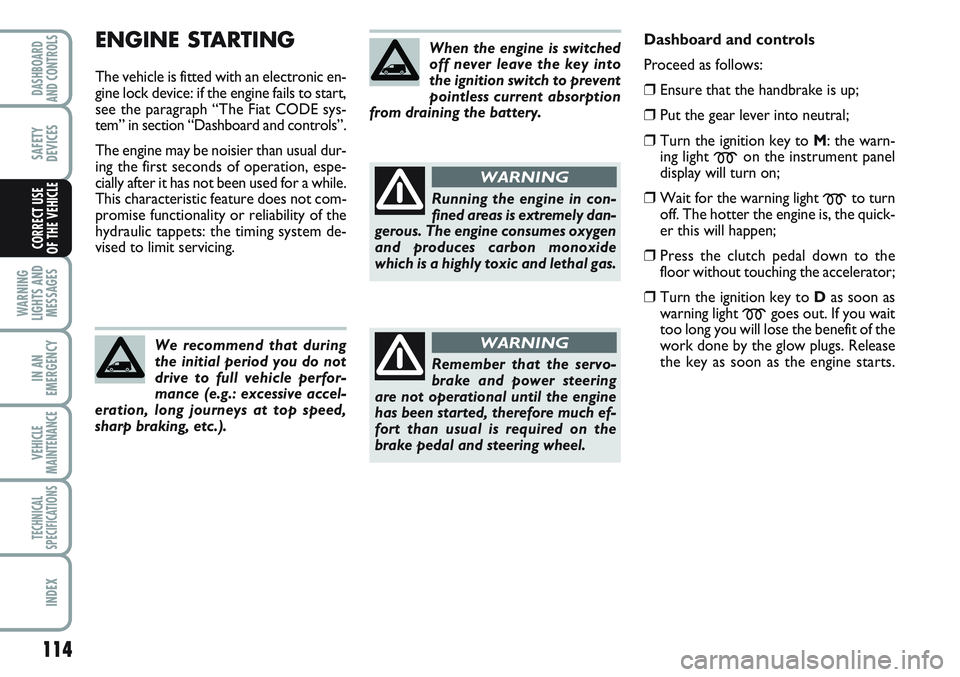
114
WARNING
LIGHTS AND
MESSAGES
IN AN
EMERGENCY
VEHICLE
MAINTENANCE
TECHNICAL
SPECIFICATIONS
INDEX
DASHBOARD
AND CONTROLS
SAFETY
DEVICES
CORRECT USE
OF THE VEHICLE
ENGINE STARTING
The vehicle is fitted with an electronic en-
gine lock device: if the engine fails to start,
see the paragraph “The Fiat CODE sys-
tem” in section “Dashboard and controls”.
The engine may be noisier than usual dur-
ing the first seconds of operation, espe-
cially after it has not been used for a while.
This characteristic feature does not com-
promise functionality or reliability of the
hydraulic tappets: the timing system de-
vised to limit servicing.
We recommend that during
the initial period you do not
drive to full vehicle perfor-
mance (e.g.: excessive accel-
eration, long journeys at top speed,
sharp braking, etc.).
When the engine is switched
off never leave the key into
the ignition switch to prevent
pointless current absorption
from draining the battery.
Running the engine in con-
fined areas is extremely dan-
gerous. The engine consumes oxygen
and produces carbon monoxide
which is a highly toxic and lethal gas.
WARNING
Remember that the servo-
brake and power steering
are not operational until the engine
has been started, therefore much ef-
fort than usual is required on the
brake pedal and steering wheel.
WARNING
Dashboard and controls
Proceed as follows:
❒Ensure that the handbrake is up;
❒Put the gear lever into neutral;
❒Turn the ignition key to M: the warn-
ing light
mon the instrument panel
display will turn on;
❒Wait for the warning light mto turn
off. The hotter the engine is, the quick-
er this will happen;
❒Press the clutch pedal down to the
floor without touching the accelerator;
❒Turn the ignition key to Das soon as
warning light
mgoes out. If you wait
too long you will lose the benefit of the
work done by the glow plugs. Release
the key as soon as the engine starts.
Page 119 of 219
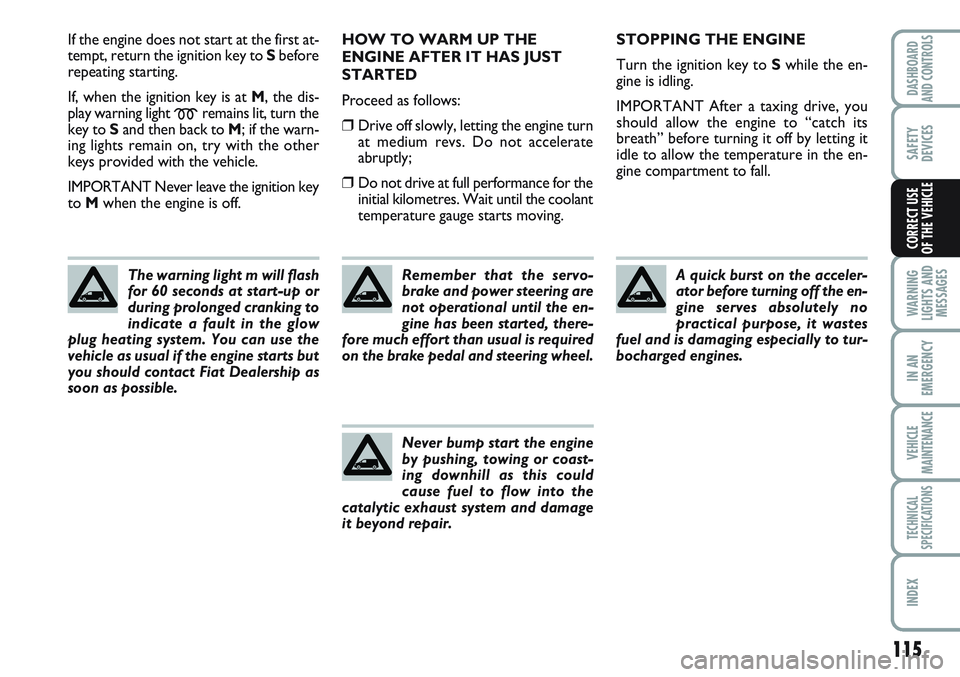
115
WARNING
LIGHTS AND
MESSAGES
IN AN
EMERGENCY
VEHICLE
MAINTENANCE
TECHNICAL
SPECIFICATIONS
INDEX
DASHBOARD
AND CONTROLS
SAFETY
DEVICES
CORRECT USE
OF THE VEHICLE
If the engine does not start at the first at-
tempt, return the ignition key to Sbefore
repeating starting.
If, when the ignition key is at M, the dis-
play warning light
mremains lit, turn the
key to Sand then back to M; if the warn-
ing lights remain on, try with the other
keys provided with the vehicle.
IMPORTANT Never leave the ignition key
to Mwhen the engine is off.
The warning light m will flash
for 60 seconds at start-up or
during prolonged cranking to
indicate a fault in the glow
plug heating system. You can use the
vehicle as usual if the engine starts but
you should contact Fiat Dealership as
soon as possible.
HOW TO WARM UP THE
ENGINE AFTER IT HAS JUST
STARTED
Proceed as follows:
❒Drive off slowly, letting the engine turn
at medium revs. Do not accelerate
abruptly;
❒Do not drive at full performance for the
initial kilometres. Wait until the coolant
temperature gauge starts moving.
Remember that the servo-
brake and power steering are
not operational until the en-
gine has been started, there-
fore much effort than usual is required
on the brake pedal and steering wheel.
Never bump start the engine
by pushing, towing or coast-
ing downhill as this could
cause fuel to flow into the
catalytic exhaust system and damage
it beyond repair.
STOPPING THE ENGINE
Turn the ignition key to Swhile the en-
gine is idling.
IMPORTANT After a taxing drive, you
should allow the engine to “catch its
breath” before turning it off by letting it
idle to allow the temperature in the en-
gine compartment to fall.
A quick burst on the acceler-
ator before turning off the en-
gine serves absolutely no
practical purpose, it wastes
fuel and is damaging especially to tur-
bocharged engines.
Page 120 of 219
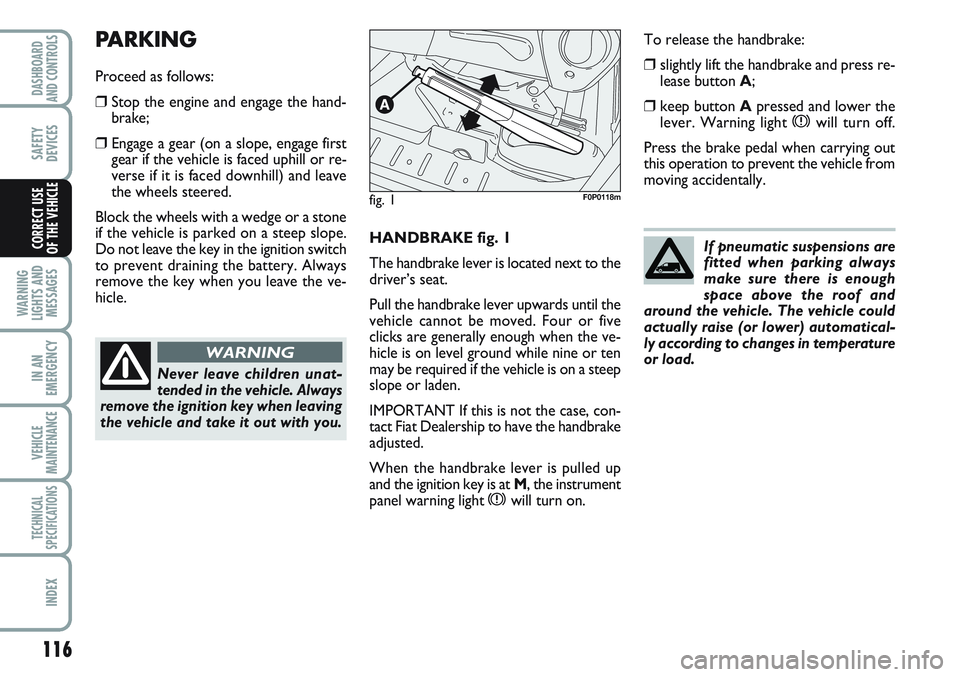
116
WARNING
LIGHTS AND
MESSAGES
IN AN
EMERGENCY
VEHICLE
MAINTENANCE
TECHNICAL
SPECIFICATIONS
INDEX
DASHBOARD
AND CONTROLS
SAFETY
DEVICES
CORRECT USE
OF THE VEHICLEHANDBRAKE fig. 1
The handbrake lever is located next to the
driver’s seat.
Pull the handbrake lever upwards until the
vehicle cannot be moved. Four or five
clicks are generally enough when the ve-
hicle is on level ground while nine or ten
may be required if the vehicle is on a steep
slope or laden.
IMPORTANT If this is not the case, con-
tact Fiat Dealership to have the handbrake
adjusted.
When the handbrake lever is pulled up
and the ignition key is at M, the instrument
panel warning light
xwill turn on.
PARKING
Proceed as follows:
❒Stop the engine and engage the hand-
brake;
❒Engage a gear (on a slope, engage first
gear if the vehicle is faced uphill or re-
verse if it is faced downhill) and leave
the wheels steered.
Block the wheels with a wedge or a stone
if the vehicle is parked on a steep slope.
Do not leave the key in the ignition switch
to prevent draining the battery. Always
remove the key when you leave the ve-
hicle.
Never leave children unat-
tended in the vehicle. Always
remove the ignition key when leaving
the vehicle and take it out with you.
WARNING
fig. 1F0P0118m
To release the handbrake:
❒slightly lift the handbrake and press re-
lease button A;
❒keep button Apressed and lower the
lever. Warning light xwill turn off.
Press the brake pedal when carrying out
this operation to prevent the vehicle from
moving accidentally.
If pneumatic suspensions are
fitted when parking always
make sure there is enough
space above the roof and
around the vehicle. The vehicle could
actually raise (or lower) automatical-
ly according to changes in temperature
or load.
Page 128 of 219
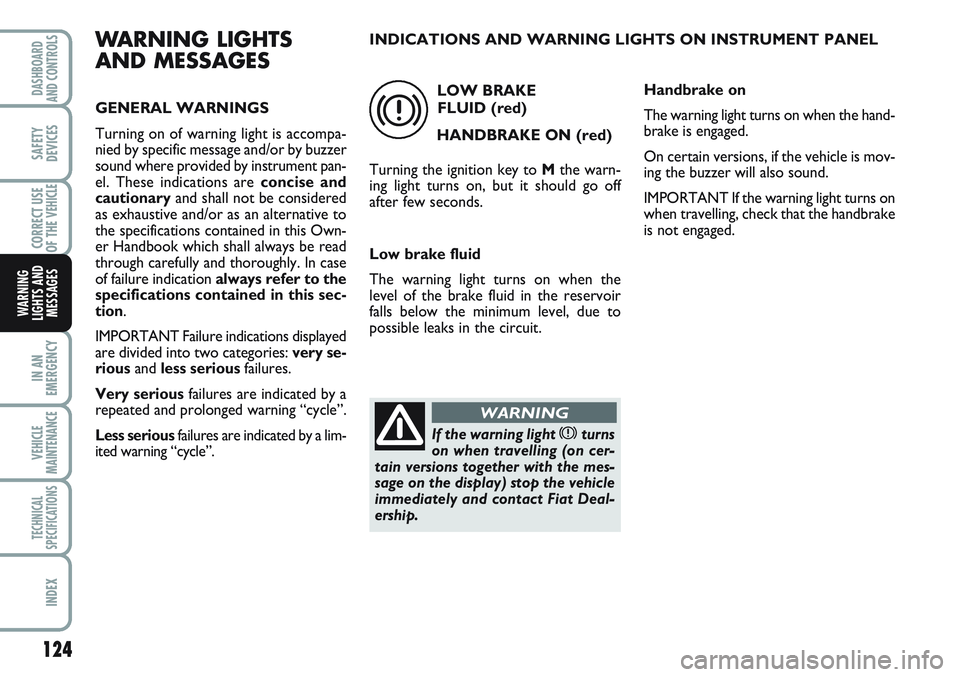
124
IN AN
EMERGENCY
VEHICLE
MAINTENANCE
TECHNICAL
SPECIFICATIONS
INDEX
DASHBOARD
AND CONTROLS
SAFETY
DEVICES
CORRECT USE
OF THE
VEHICLE
WARNING
LIGHTS AND
MESSAGES
WARNING LIGHTS
AND MESSAGES
GENERAL WARNINGS
Turning on of warning light is accompa-
nied by specific message and/or by buzzer
sound where provided by instrument pan-
el. These indications are concise and
cautionaryand shall not be considered
as exhaustive and/or as an alternative to
the specifications contained in this Own-
er Handbook which shall always be read
through carefully and thoroughly. In case
of failure indication always refer to the
specifications contained in this sec-
tion.
IMPORTANT Failure indications displayed
are divided into two categories: very se-
riousand less seriousfailures.
Very seriousfailures are indicated by a
repeated and prolonged warning “cycle”.
Less seriousfailures are indicated by a lim-
ited warning “cycle”.
LOW BRAKE
FLUID (red)
HANDBRAKE ON (red)
Turning the ignition key to Mthe warn-
ing light turns on, but it should go off
after few seconds.
Low brake fluid
The warning light turns on when the
level of the brake fluid in the reservoir
falls below the minimum level, due to
possible leaks in the circuit.
x
If the warning light xturns
on when travelling (on cer-
tain versions together with the mes-
sage on the display) stop the vehicle
immediately and contact Fiat Deal-
ership.
WARNING
Handbrake on
The warning light turns on when the hand-
brake is engaged.
On certain versions, if the vehicle is mov-
ing the buzzer will also sound.
IMPORTANT If the warning light turns on
when travelling, check that the handbrake
is not engaged. INDICATIONS AND WARNING LIGHTS ON INSTRUMENT PANEL